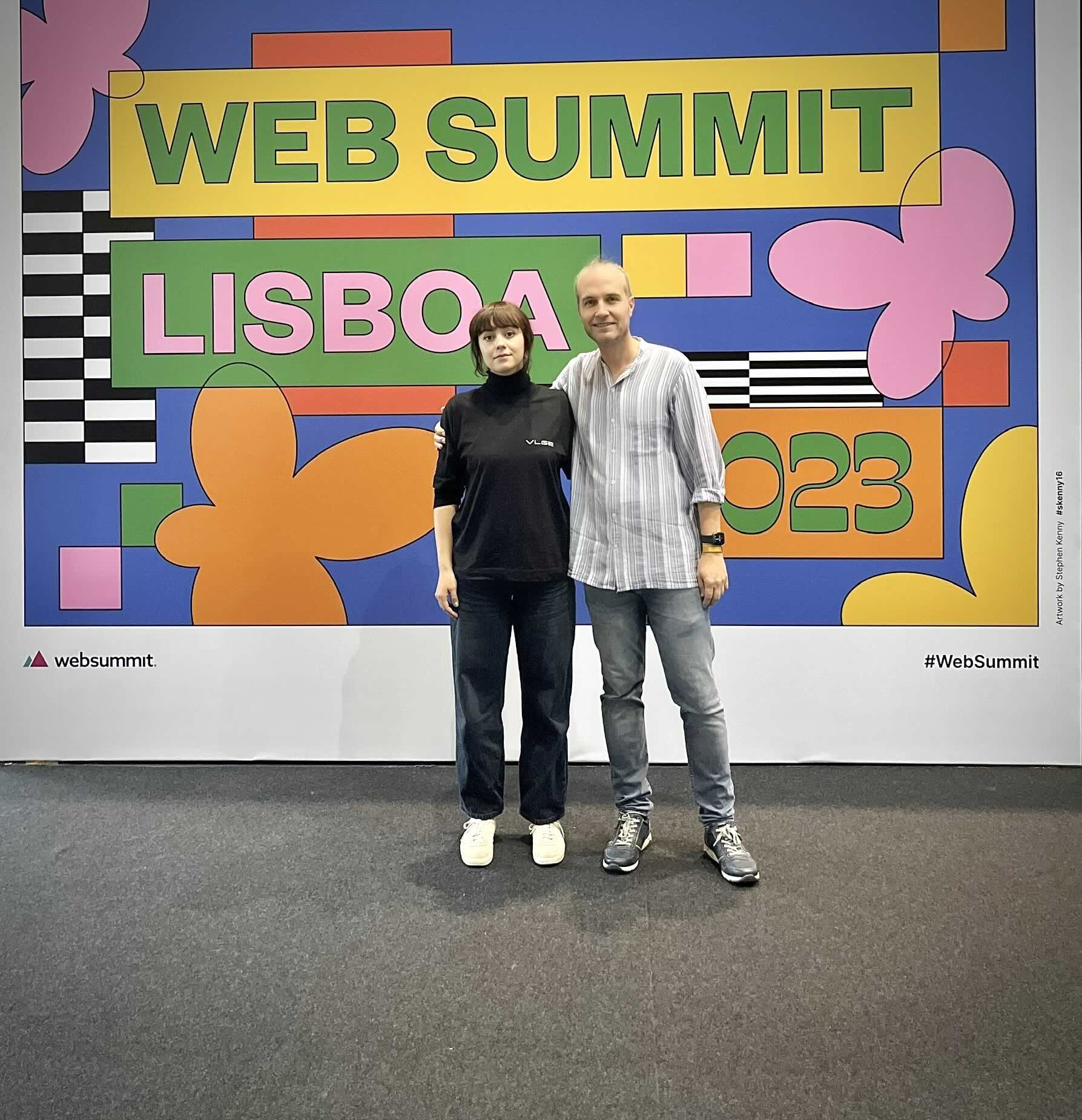Wondering how storytelling intertwines with technology to redefine our reality? Or perhaps you're curious about how spatial computing could revolutionize industries like fashion, education, and beauty?
Join us as we engage in a riveting discussion with the founder and CEO of VLGE, Evelyn Mora, and unravel the vast potential of spatial computing in crafting immersive virtual worlds accessible to all.
Dive deeper as we explore the facets of sustainability and inclusivity in spatial computing. Elevate your understanding with Evelyn's invaluable insights into how to prioritize accessibility, build sustainable virtual spaces, and the upcoming Apple Vision Pro's role in shaping the future of spatial computing. Further the conversation transitions to the Web Summit, Evelyn shares her experiences and thoughts on spatial computing's transformative role in our interaction with technology and sustainability efforts. Be prepared for a thought-provoking conversation exploring the unlimited possibilities of spatial computing. Make sure to share this compelling episode and subscribe to our podcast for more such fascinating discussions.
Unleashing the Power of Spatial Computing with VLGE
Imagine a world where you can create your own virtual reality, shaping it according to your preferences and needs. This is no longer just a concept but a reality made possible by spatial computing and platforms like VLGE.
This article delves into the fascinating realm of spatial computing, focusing on how storytelling plays an integral role in this digital-physical blend. It introduces us to VLGE (pronounced “Village”), a company that's democratizing the creation process through its no-code drag-and-drop world building design tool. The discussion further explores how spatial computing impacts various industries such as fashion, art, and digital marketing by providing immersive experiences for consumers.
The importance of balancing creativity with technology in spatial computing is highlighted along with considerations around user-centric design and sustainable thinking. Furthermore, we delve into critical aspects like sustainability and accessibility within this rapidly evolving field while also touching upon real-life problems that could be addressed using this technology.
All these intriguing facets will be discussed in detail throughout the article, shedding light on how companies like VLGE are empowering individuals to shape their future through spatial computing.
The Power of Storytelling in Spatial Computing
Storytelling plays a significant role in various aspects of our lives, including advertising, politics, and religion. It is through stories that cultures pass down their knowledge and values to future generations. In the context of spatial computing, where digital and physical realms merge, it becomes crucial to provide everyone with the opportunity to shape this new reality. This is precisely why VLGE was founded - to remove technological barriers and empower individuals to build their own virtual realities.
VLGE is a company that is developing a no code drag and drop world building design tool. With this tool, anyone can create immersive worlds from start to finish in a matter of minutes. By democratizing the creation process, VLGE aims to enable individuals from all walks of life to participate in shaping the future of spatial computing.
When we think about spatial computing and the concept of virtual worlds, it's important to note that it is not synonymous with the metaverse. The metaverse represents the blending of digital and physical elements, but its definition is still evolving as the industry is in its early stages. Spatial computing encompasses the immersive virtual worlds that are emerging as digital and physical realms continue to intertwine. As this technology progresses, it will be fascinating to see how these virtual worlds become integrated into our daily lives and how storytelling evolves within this new medium.
The Intersection of Spatial Computing and Digital Marketing
As spatial computing continues to evolve, it is inevitable that it will have a significant impact on digital marketing and customer engagement. One of the key aspects of digital marketing is storytelling, which is used to generate particular emotions in consumers. Whether it's creating a sense of empathy or fear of missing out (FOMO), storytelling plays a crucial role in capturing the attention and interest of potential customers.
In the realm of spatial computing, storytelling takes on a new dimension. Immersive virtual worlds provide marketers with the opportunity to create interactive narratives that deeply engage their audience. By leveraging gamification techniques, marketers can entertain and educate people about their products or services in a more immersive and memorable way. This not only enhances the overall customer experience but also fosters a stronger connection between the brand and its target audience.
For example, in the fashion industry, brands are known for their captivating stories that go beyond just showcasing their products. Consumers are drawn to the narratives behind the brand, as they reflect their own identities and values. With spatial computing, fashion brands can take storytelling to a whole new level by allowing customers to virtually explore their collections, try on different outfits, and even participate in virtual fashion shows. This not only enhances the shopping experience but also enables brands to convey their unique stories in a more interactive and engaging manner.
While fashion is just one example, the potential of spatial computing extends to various industries such as beauty and art. These creative industries are closely tied to our identities and how we express ourselves as individuals. By leveraging spatial computing, artists can create immersive experiences that allow people to interact with their artwork in ways that were previously unimaginable. Similarly, beauty brands can use virtual reality to provide customers with personalized makeup tutorials or virtual try-on experiences.
Balancing Creativity and Technology in Spatial Computing
One of the key challenges in spatial computing is finding the right balance between creativity and technology. On one hand, virtual worlds and immersive experiences rely heavily on creative elements such as concept art, storytelling, and design. These creative aspects are essential in capturing the attention and interest of users, as well as conveying the brand's unique identity and values.
However, it is equally important to marry these creative elements with technology to ensure a seamless and immersive user experience. This is where the expertise of technologists comes into play. At VLGE, a diverse group of talented artists and technologists work together to build a platform that enables users to tell their own stories and bring them to life in virtual worlds.
One of the key considerations in this process is user-centric design. The team at VLGE puts themselves in the position of the user and thinks about how they would want to tell a story or create an immersive experience. This approach ensures that the technology serves as a tool to enhance creativity and storytelling, rather than overshadowing it.
In addition to user-centric design, sustainable thinking is also a core aspect of VLGE’s mission. The team recognizes that digital sustainability encompasses various dimensions, including mental health, inclusion, diversity, and economic factors. They take all these elements into account when building their tools, ensuring that accessibility and social sustainability are prioritized.
By removing technological barriers and providing easy access to self-expression, VLGE aims to empower individuals from all walks of life to shape the future of spatial computing. Their focus on accessibility and inclusivity reflects a commitment to creating virtual spaces that have a positive impact on users' lives.
The Role of Sustainability and Accessibility in Spatial Computing
In the rapidly evolving field of spatial computing, it is crucial to consider the role of sustainability and accessibility. These two factors play a significant role in shaping the future of virtual worlds and immersive experiences.
The various layers of digital sustainability
Digital sustainability encompasses various dimensions, including mental health, inclusion, diversity, and economic factors. It is not just about creating visually stunning virtual spaces, but also about ensuring that these spaces are accessible and beneficial for all users.
For example, mental health is a growing concern in today's digital age. Excessive screen time and the constant exposure to virtual environments can have negative effects on individuals' well-being. Therefore, it is essential to design virtual experiences that promote mental well-being and provide a healthy balance between the digital and physical worlds.
Inclusion and diversity are also critical aspects of digital sustainability. Virtual spaces should be accessible to people of all abilities and backgrounds. This means considering factors such as language barriers, physical disabilities, and cultural sensitivities when designing immersive experiences.
The importance of considering social sustainability aspects
In addition to mental health, inclusion, and diversity, social sustainability also encompasses other important aspects such as cybersecurity. As virtual worlds become more integrated into our daily lives, it is crucial to ensure the safety and privacy of users' personal information.
Cybersecurity measures should be implemented to protect users from potential threats such as data breaches or identity theft. This includes robust encryption protocols, secure authentication methods, and regular security updates to mitigate any vulnerabilities.
The need for long-term thinking and accessibility
When developing virtual spaces, it is essential to adopt a long-term mindset. Instead of focusing on short-term trends or one-time events, the goal should be to create virtual experiences that have longevity and can be utilized on an everyday basis.
Accessibility is a key factor in achieving this goal. Virtual spaces should be easily accessible to users, regardless of their technological expertise or financial resources. This means designing platforms that are user-friendly, compatible with various devices, and do not require expensive hardware or high-speed internet connections.
The potential of spatial computing in solving real-life problems
Spatial computing has the potential to address real-life problems such as overconsumption and mental health issues. By leveraging the immersive nature of virtual worlds, spatial computing can provide innovative solutions and experiences that promote sustainable practices and improve well-being.
For example, virtual shopping experiences can help reduce overconsumption by allowing users to visualize products in a virtual environment before making a purchase. This can minimize the need for physical returns and reduce waste.
In terms of mental health, spatial computing can offer therapeutic experiences that help individuals relax, unwind, and manage stress. Virtual environments can simulate calming natural landscapes or provide interactive activities that promote mindfulness and emotional well-being.
Overall, the future of spatial computing lies in its ability to address real-life challenges and create positive impacts on society. By prioritizing sustainability and accessibility, virtual worlds can become inclusive spaces that enhance users' lives while minimizing negative effects on the environment and individual well-being.
The Challenges and Lessons in Building a Sustainable Business
Building a sustainable business is no easy task, and Evelyn has faced numerous challenges and learned valuable lessons along the way. One of the biggest challenges she encountered in growing her company was finding like-minded individuals who shared her passion for sustainability. While there may have been plenty of candidates, it was crucial to bring on board people who were willing to selflessly contribute to the greater good.
Hiring the right people is essential for any organization, but it becomes even more critical when sustainability is at the core of the company's mission. It requires individuals who not only possess the necessary skills and expertise but also align with the values and ethical purpose of the company. This alignment ensures that everyone is working towards a common goal and is committed to building something that will have a positive impact on society.
Over the past two years, Evelyn's main focus as CEO has been to marry these values with the commercial aspects of running a business. It is not enough to have a noble mission; the company also needs to generate revenue and sustain its growth. Finding the balance between profitability and sustainability has been a significant learning experience for Evelyn.
She firmly believes that it is possible to build a commercial and sustainable business without resorting to greenwashing or making empty promises. It is about staying true to the core values and ethical purpose that drove her to start the company in the first place. By maintaining this integrity, she has been able to navigate through various challenges such as go-to-market strategies, competition, user demands, and board expectations.
The Future of Spatial Computing and User Engagement
Looking ahead, Evelyn is filled with excitement about the future of spatial computing and the possibilities it holds for user engagement. One of the things that excites her the most is seeing what users will build on the VLGE platform. By listening to their users and evolving the product based on their feedback, VLGE aims to create a diverse range of content that caters to different interests and preferences.
What sets VLGE apart is its accessibility. Evelyn takes pride in the fact that they have built a profitable business at a price point that is accessible to the majority of people. This means that more individuals can participate in the spatial computing revolution and experience the benefits it offers. To further enhance accessibility, VLGE also plans to provide different programs and opportunities that cater to a wide range of users.
For Evelyn, the future of spatial computing is all about empowerment. She envisions a world where individuals have control over their digital lives and can shape their own experiences. The blending of the internet into physical reality opens up endless possibilities, but it is crucial for users to have agency and be able to decide how they want this integration to look like in their lives.
This vision of empowerment stems from Evelyn's own experience as a user on platforms where she felt helpless and unable to make any changes. She wanted to create a platform where users have the power to shape their own digital experiences and not be limited by predefined services or constraints. By giving users control, VLGE aims to empower individuals and enable them to create meaningful connections in their digital lives.
The Role of Participation in Shaping the Future of Spatial Computing
One of the key aspects that Evelyn emphasizes when discussing the future of spatial computing is the importance of user participation. She believes that user feedback plays a crucial role in evolving the VLGE platform and shaping its direction. By listening to their users and understanding their needs, VLGE can continuously improve and provide a better experience for everyone.
Furthermore, Evelyn encourages users to actively influence the future of spatial internet. She wants individuals to realize that they have the power to shape their own digital lives and decide what the integration of the internet into physical reality looks like for them. This empowerment allows users to have agency over their experiences and create a personalized and meaningful connection with the digital world.
Evelyn firmly believes that participation is key to controlling our digital lifestyles. By actively engaging with platforms like VLGE, users can have a say in how their digital experiences unfold. This stands in contrast to traditional platforms where users are often limited by predefined services and have little control over customization. With VLGE, individuals can break free from these constraints and have the freedom to create a digital environment that aligns with their values and preferences.
To encourage user participation, VLGE offers a free trial for individuals to try out the product. This allows users to explore the platform, experience its features firsthand, and provide valuable feedback. By sharing their thoughts and insights, users can contribute to the ongoing development of VLGE and help shape its future direction.
The Impact of Spatial Computing on Sustainability and the Future
Evelyn recognizes the immense potential of spatial computing in shaping the future. She believes that this technology has the power to revolutionize how we interact with the digital world and our physical surroundings. By seamlessly blending the internet into our everyday lives, spatial computing can create immersive experiences that enhance our productivity, communication, and overall well-being.
However, Evelyn also emphasizes the importance of sustainability in the development of spatial computing. She believes that it is crucial for companies in this industry to prioritize ethical practices and have a positive impact on society and the environment. For Evelyn, sustainability is not just about creating a profitable business, but also about building something that serves the greater good.
In her role as CEO of VLGE, Evelyn has faced numerous challenges in finding like-minded individuals who share her vision of sustainability. Hiring has been difficult not because there is a lack of candidates, but because she wants to bring people onto the platform who are genuinely passionate about building something for the greater good. This focus on finding individuals who align with VLGE’s values has been instrumental in ensuring that the company remains true to its core purpose.
Evelyn's main mission as CEO is to marry these values of sustainability with the commercial aspects that will fuel VLGE’s evolution in a sustainable way. She firmly believes that it is possible to build a commercial and sustainable business without resorting to greenwashing or compromising on ethical principles. By staying true to their values and core purpose, companies can create a positive impact while also achieving financial success.
As Evelyn reflects on her journey as CEO, she acknowledges that there are many important questions to consider when building a sustainable business. These questions range from go-to-market strategies and timelines to understanding competitors, user needs, and even board expectations for venture-backed startups. By addressing these questions and finding the right balance between commercial success and sustainability, Evelyn has been able to steer VLGE in the right direction.
The Excitement of User-Driven Evolution in Spatial Computing
One of the aspects that excites Evelyn the most about the future of spatial computing is the user-driven evolution of the VLGE platform. She believes that by listening to their users and understanding their needs, VLGE can continuously improve and provide a better experience for everyone. The diversity of content that users will build on Village is something that truly excites Evelyn, as it showcases the potential of spatial computing to empower individuals and enable them to shape their own digital lives.
What sets VLGE apart from other platforms is its accessibility. Evelyn is proud that they have managed to build a profitable business at a price point that is accessible to the majority of people. However, she also wants to ensure that VLGE remains accessible for everybody, regardless of their background or financial means. To achieve this, Village will be introducing different programs and opportunities that will make it even more inclusive.
Evelyn's passion for empowering users stems from her own experience as a consumer on platforms where she felt helpless and unable to change anything. This realization was the driving force behind the creation of VLGE. She wanted to provide a platform where users have control over their digital experiences and can shape their own online environment according to their preferences.
Participation is key in shaping the future of spatial computing, according to Evelyn. She believes that by actively engaging with platforms like VLGE, individuals can have a say in how their digital lives unfold. This stands in stark contrast to traditional platforms where users are often limited by predefined services and have little control over customization. With VLGE, users can break free from these constraints and create a digital environment that aligns with their values and preferences.
Sharing Knowledge and Joining the Conversation
Evelyn encourages listeners to share their knowledge about spatial computing with others. By spreading awareness and engaging in conversations about the future of this technology, individuals can contribute to its growth and development. Sharing this episode with marketers, entrepreneurs, and people in their network who may find it useful is one way to help foster a community of individuals interested in spatial computing.
To further engage with the topic, Evelyn invites listeners to subscribe to the show. By subscribing, individuals can stay updated on the latest episodes and continue learning about spatial computing and its potential impact on various industries. Subscribing also allows them to be part of the ongoing conversation and join others in shaping the future of this exciting field.
In addition, Evelyn directs listeners to vlge.com, where they can try out the VLGE platform through a free trial. This opportunity enables users to explore the features of VLGE firsthand and provide valuable feedback. By actively participating in the platform, individuals can have a direct impact on its evolution and help shape how the spatial internet and immersive life will look like in the future.
Evelyn firmly believes that participation is key to controlling our digital lifestyles. By actively engaging with platforms like VLGE, users can have agency over their experiences and create a personalized connection with the digital world. Through participation, individuals can influence how their digital lives unfold and play a role in shaping the future of spatial computing.
Wrapping Up
As we conclude, it's clear that spatial computing is a rapidly evolving field with immense potential. It offers the opportunity to revolutionize how we interact with both digital and physical worlds, creating immersive experiences that enhance our lives in numerous ways.
The company VLGE stands out for its commitment to accessibility and inclusivity, aiming to empower individuals from all walks of life to shape their own virtual realities through an easy-to-use platform.
Sustainability plays a crucial role in this development process. Companies like VLGE are prioritizing ethical practices and positive societal impact alongside commercial success, demonstrating that profitability and sustainability can coexist.
User participation is key in shaping the future of spatial computing. By actively engaging with platforms like VLGE, users have agency over their experiences and can create personalized connections within the digital world.
But as exciting as these developments are, they also raise important questions: How do we ensure these new technologies remain accessible for everyone? And how do we balance rapid innovation with sustainable practices? Until next time!

Joeri Billast and Evelyn Mora at the Web Summit podcast booth
KEY HIGHLIGHTS
[01:52] What are you exactly doing at VLGE?
[02:27] Are you working on the virtual world, spatial, or Metaverse at VLGE?
[03:50] Can you elaborate on the takeaways from the discussions about gamey fight storytelling and your insights on storytelling at VLGE?
[05:41] How do virtual worlds and spatial computing impact digital marketing and what possibilities do they present for customer engagement?
[07:07] How expansive are the possibilities of spatial computing, especially considering its applications in fashion and education, as you mentioned?
[09:19] How do you navigate and find the appropriate balance between the creative and technical aspects of spatial computing?
[11:13] How do you guarantee that advanced machine spatial computing and digital experiences align with sustainable practices?
[13:41] For listeners who are interested in exploring spatial computing but also prioritize sustainability, what advice would you offer to guide them as potential innovators in this space?
[17:38] Considering fashion, marketing, and community building, how do you foresee spatial computing evolving, especially within the context of the Web3 space?
[21:30] Could you share a specific challenge or lesson you've encountered in your journey with VLGE or spatial computing and the insights gained from overcoming it?
[23:45] Looking ahead to the coming months or year, what aspect of spatial computing or the work with your company are you most excited about?
NOTABLE QUOTES
"So basically, what we do at VLGE is we're building a no-code drag and drop world building design tool, so we essentially enable anyone to build immersive worlds from vision to execution to deployment in minutes."
"To me, metaverse is essentially digital elements kind of blending into physical elements. I don't like to define things so strictly because I feel like the industry and this news, let's say revolution, is in such an early stage that I feel like we're yet to discover what spatial computing is really going to look like..."
"Fashion brands are some of the best storytellers in the world. We buy into the stories, not into that t-shirt that we see in the advertisements."
"The possibilities of special computing I think it's unlimited and for us, really, our niche is fashion, beauty and art. I feel like fashion is very, in beauty and art, very closely connected to our identities..."
"Technology should be the answer and not the barrier, right?"
MENTIONED RESOURCES
VLGE Website: https://www.vlge.com/
VLGE LinkedIn: https://www.linkedin.com/company/vlge-com/






